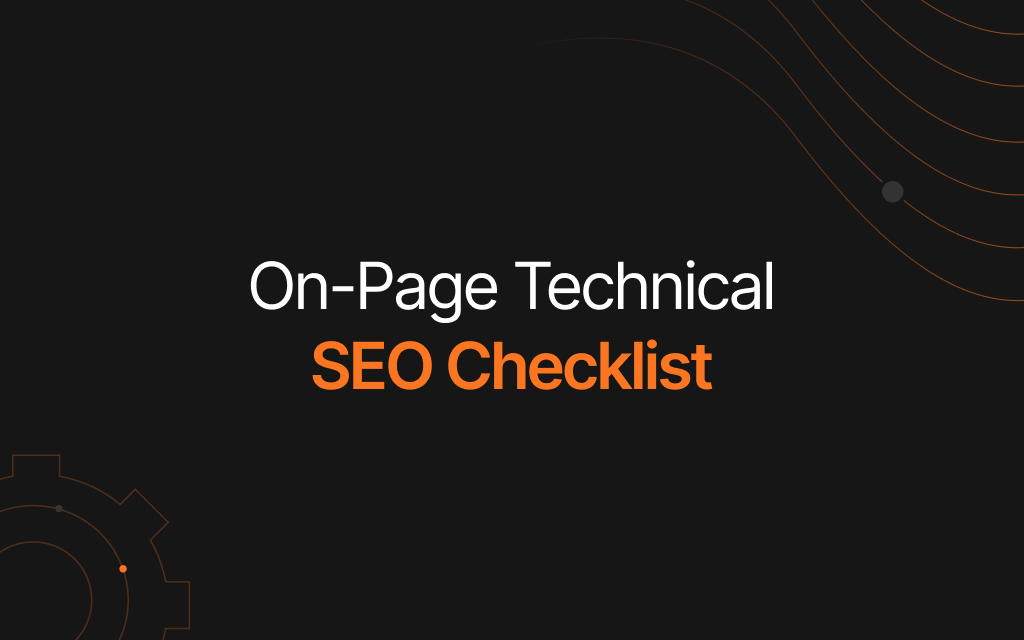Are you struggling to get your website to rank higher in search engines? Technical SEO is the foundation of any successful search engine optimization strategy. Technical SEO involves optimizing your website’s infrastructure and code to make it more search-engine friendly.
In this article, we’ll provide you with a comprehensive technical SEO checklist that covers everything you need to know to optimize your website. From website speed to schema markup, we’ll cover it all. So, let’s get started!
What Is Technical SEO
Technical SEO is the process of optimizing your website’s infrastructure and code to make it more search-engine friendly. Technical SEO is the foundation of any successful SEO strategy, as it ensures that search engines can crawl and index your website properly.
In this article, we’ll provide you with a step-by-step guide to optimizing your website for technical SEO. We’ll cover everything from website speed and performance to on-page optimization and off-page optimization.
Understanding Technical SEO
Before diving into technical SEO, it’s crucial to understand its importance. Technical SEO optimizes a website’s infrastructure and code for better search engine friendliness. It includes website speed, mobile-friendliness, security, crawling and indexing, and more.
By optimizing technical SEO, you improve search engine visibility and increase organic traffic to your website.
Website Speed and Performance
Website speed and performance is a crucial aspect of technical SEO. A fast website not only improves the user experience but also helps your website rank higher in search engines.
Here are some tips to optimize your website speed and performance:
Optimize Images
Images can slow down your website if they’re not optimized. Make sure to compress your images before uploading them to your website. You can use tools like Photoshop or online image compressors to reduce the file size of your images without sacrificing quality.
Minimize HTTP Requests
Each element on your website, including images, scripts, and stylesheets, requires an HTTP request to load. The more HTTP requests your website makes, the slower it will be. You can minimize HTTP requests by reducing the number of elements on your website or by combining multiple files into one.
Reduce Server Response Time
Server response time is the amount of time it takes for your server to respond to a request from a user’s browser. A slow server response time can slow down your website. To reduce server response time, choose a reliable web hosting provider and optimize your website’s code.
Implement Browser Caching
Browser caching allows your website to store temporary files, such as images and stylesheets, on a user’s device. When the user revisits your website, the files are already stored on their device, which speeds up the loading time. You can implement browser caching by adding caching headers to your website’s code.
Use a Content Delivery Network (CDN)
A content delivery network (CDN) is a network of servers that stores your website’s files in multiple locations around the world. When a user requests a file from your website, the CDN serves the file from the server that’s closest to the user’s location, which speeds up the loading time. You can use a CDN to improve your website’s speed and performance.
Enable Gzip Compression
Gzip compression is a method of compressing files before they’re sent to a user’s browser. Compressed files are smaller in size, which reduces the loading time. You can enable Gzip compression by adding compression headers to your website’s code.
Mobile Friendliness
Mobile friendliness is another important aspect of technical SEO. More and more people are using mobile devices to browse the internet, so it’s crucial that your website is mobile-friendly.
Here are some tips to make your website mobile-friendly:
Use Responsive Design
Responsive design allows your website to adjust to different screen sizes. This means that your website will look good on any device, whether it’s a desktop computer, a tablet, or a smartphone.
Implement AMP (Accelerated Mobile Pages)
Accelerated mobile pages (AMP) is a framework that allows your website to load faster on mobile devices. AMP strips down your website’s code to its bare essentials, which reduces the loading time. You can implement AMP by adding AMP tags to your website’s code.
Test Your Website on Multiple Devices
Make sure to test your website on multiple devices to ensure that it looks good and functions properly on all screen sizes. You can use tools like Google’s Mobile-Friendly Test to test your website’s mobile-friendliness.

On-Page Optimization
On-page optimization involves optimizing the content on your website to make it more search-engine friendly. Here are some tips to optimize your website’s on-page SEO:
Optimize Title Tags
Title tags are the titles of your web pages that appear in search engine results pages (SERPs). Make sure to include your target keywords in your title tags and keep them under 60 characters.
Optimize Meta Descriptions
Meta descriptions are the brief summaries that appear below your title tags in SERPs. Make sure to include your target keywords in your meta descriptions and keep them under 160 characters.
In case you are not able to describe essential info about the content within the recommended character limit, then consider shortening the description with an AI summarizer.
Use Header Tags
Header tags (H1, H2, H3, etc.) are used to structure your content and make it easier to read. Make sure to include your target keywords in your header tags and use them to organize your content.
Optimize the Content
Optimizing your content involves using your target keywords throughout your website’s content. Make sure to use your target keywords naturally and don’t overuse them.
Use Internal Linking
Internal linking involves linking to other pages on your website. This helps search engines understand the structure of your website and how pages are related to each other. Make sure to use descriptive anchor text when linking to other pages on your website.
Use Outbound Links
Outbound links are links that point to other websites. Make sure to include outbound links in your content to provide additional information and context to your readers. However, make sure to only link to high-quality, relevant websites.
Implement Schema Markup
Schema markup is a type of structured data that provides additional information about your website’s content to search engines. Implementing schema markup can help your website appear in rich snippets on search engine results pages.
Website Security
Website security is another important aspect of technical SEO. A secure website not only protects your users but also helps your website rank higher in search engines.
Here are some tips to improve your website’s security:
Use HTTPS
HTTPS is a secure version of the HTTP protocol that encrypts data sent between a user’s browser and your website’s server. Using HTTPS can help protect your users’ data and improve your website’s security.
Keep Your Website Software Up-to-Date
Make sure to keep your website’s software, including your content management system (CMS) and plugins, up-to-date. Outdated software can contain security vulnerabilities that can be exploited by hackers.
Use Strong Passwords
Use strong passwords for your website’s accounts to prevent unauthorized access. Make sure to use a combination of letters, numbers, and special characters, and avoid using common words or phrases.
Implement Two-Factor Authentication (2FA)
Two-factor authentication (2FA) adds an extra layer of security to your website’s accounts by requiring users to enter a code in addition to their password. Implementing 2FA can help protect your website from unauthorized access.
Crawling and Indexing
Crawling and indexing is the process that search engines use to discover and rank your website’s pages. Here are some tips to optimize your website for crawling and indexing:
Check for Broken Links
Broken links can harm your website’s SEO by creating a poor user experience and preventing search engines from crawling your website. Make sure to regularly check for broken links and fix them.
Submit an XML Sitemap
An XML sitemap is a file that lists all of your website’s pages and provides additional information about them to search engines. Submitting an XML sitemap can help search engines discover and crawl your website’s pages.
Use Robots.txt
Robots.txt is a file that tells search engines which pages on your website to crawl and which pages to exclude. Make sure to use robots.txt to control which pages search engines can access.
Use Canonical Tags
Canonical tags are used to tell search engines which version of a page to index. Use canonical tags to avoid duplicate content issues and ensure that search engines are indexing the correct version of your pages.
Monitor Your Website’s Indexing Status
Make sure to regularly monitor your website’s indexing status in search engines. If you notice a decrease in indexed pages, there may be an issue with your website’s crawling and indexing.
Off-Page Optimization
Off-page optimization involves optimizing factors outside of your website that can affect your search engine rankings. Here are some tips to optimize your website’s off-page SEO:
Build High-Quality Backlinks
Backlinks are links from other websites that point to your website. High-quality backlinks can improve your website’s authority and help it rank higher in search engines. Make sure to focus on building high-quality backlinks from relevant websites.
Monitor Your Backlink Profile
Make sure to regularly monitor your backlink profile to ensure that you’re not receiving low-quality or spammy backlinks. Low-quality backlinks can harm your website’s SEO and reputation.
Social Media Optimization
Social media optimization involves optimizing your social media profiles and content to improve your website’s visibility and engagement on social media. Make sure to share your website’s content on social media and engage with your followers to build a strong social media presence.

On-Page Technical SEO Checklist
Here’s a comprehensive table checklist for on-page technical SEO:
| Category | SEO Items | SEO Tasks | Things to Take Note |
|---|---|---|---|
| Title Tags | Title Tags | Include target keywords, keep under 60 characters | Use unique title tags for each page |
| Meta Descriptions | Meta Descriptions | Include target keywords, keep under 160 characters | Use unique meta descriptions for each page |
| Header Tags | H1, H2, H3, etc. | Use header tags to structure content and include target keywords | Use descriptive header tags |
| Content Optimization | Target Keywords | Use target keywords naturally throughout the content | Don’t overuse target keywords |
| Internal Linking | Internal Links | Link to other pages on your website with descriptive anchor text | Use relevant internal links |
| Outbound Linking | Outbound Links | Link to high-quality, relevant websites | Don’t overuse outbound links |
| Schema Markup | Structured Data | Implement schema markup to provide additional information to search engines | Use relevant schema markup |
| Mobile Friendliness | Responsive Design, AMP, Testing | Use responsive design, implement AMP, and test the website on multiple devices | Make sure the website is mobile-friendly |
| Website Speed and Performance | Image Optimization, Minimizing HTTP Requests, Server Response Time, Browser Caching, CDN, Gzip Compression | Optimize images, minimize HTTP requests, reduce server response time, enable browser caching, use a CDN, enable Gzip compression | Improve website speed and performance |
| Website Security | HTTPS, Up-to-Date Software, Strong Passwords, 2FA | Use HTTPS, keep website software up-to-date, use strong passwords, implement 2FA | Improve website security |
| Crawling and Indexing | Broken Links, XML Sitemap, Robots.txt, Canonical Tags, Monitoring | Check for broken links, submit an XML sitemap, use robots.txt, use canonical tags, monitor the website’s indexing status | Optimize the website for crawling and indexing |
| Off-Page Optimization | Backlinks, Backlink Profile Monitoring, Social Media Optimization | Build high-quality backlinks, monitor backlink profiles, optimize social media profiles and content | Improve off-page SEO |
Optimizing your website for technical SEO can seem overwhelming, but it’s crucial for improving your website’s search engine rankings and driving organic traffic.
By following this technical SEO checklist, you can ensure that your website is optimized for speed, mobile-friendliness, security, and search engine crawling and indexing.
Remember to regularly monitor your website’s SEO performance and make adjustments as needed. Technical SEO is an ongoing process that requires constant attention and optimization.
FAQs
- What is technical SEO? A: Technical SEO involves optimizing your website’s infrastructure and code to make it more search-engine friendly.
- Why is technical SEO important? A: Technical SEO is important because it ensures that search engines can crawl and index your website effectively, which can improve your website’s search engine rankings and drive organic traffic.
- How often should I update my website’s software? A: You should update your website’s software, including your content management system (CMS) and plugins, as soon as updates become available. Outdated software can contain security vulnerabilities that can be exploited by hackers.
- How do I build high-quality backlinks? A: You can build high-quality backlinks by creating high-quality content that other websites will want to link to, reaching out to other websites and asking them to link to your content, and participating in guest blogging and other content marketing strategies.
- What is a content delivery network (CDN)? A: A content delivery network (CDN) is a network of servers that stores your website’s files in multiple locations around the world. When a user requests a file from your website, the CDN serves the file from the server that’s closest to the user’s location, which speeds up the loading time.
- How do I test my website’s mobile-friendliness? A: You can test your website’s mobile-friendliness using tools like Google’s Mobile-Friendly Test. This tool will analyze your website and provide suggestions for improving its mobile-friendliness.
By following this ultimate technical SEO checklist, you can ensure that your website is optimized for search engines and provide a better user experience for your visitors. Regularly monitoring and updating your website’s technical SEO can help improve your search engine rankings and drive more organic traffic to your website.
Keen to Work With Us?
Achieve your business objectives and showcase your brand’s personality with our website design and development services. Our expert team can collaborate with you to design a bespoke website that caters to your specific needs.
Our service catalog encompasses cutting-edge design trends and technologies, including responsive design, e-commerce integration, and customized functionality.
Get in touch with us today to start your website project and discover the power of a website that embodies your brand.







